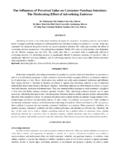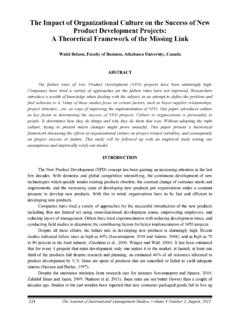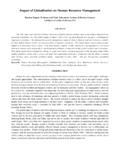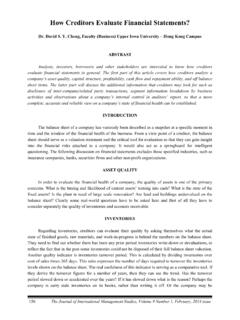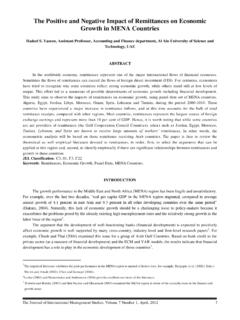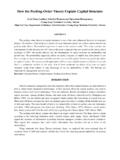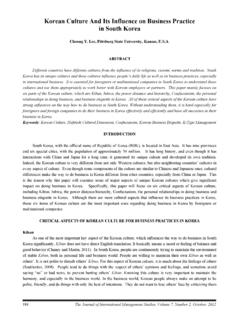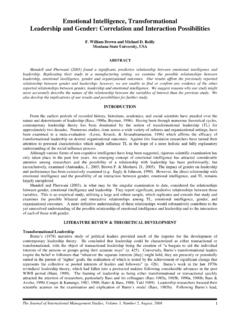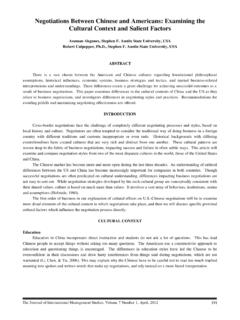Transcription of The Impact of Brand Awareness on Consumer Purchase ...
1 The Journal of International Management Studies, Volume 4, Number 1, February, 2009 135 The Impact of Brand Awareness on Consumer Purchase Intention: The Mediating Effect of Perceived Quality and Brand Loyalty Dr. Hsin Kuang Chi, Nanhua University, Taiwan Dr. Huery Ren Yeh, Shih Chien University, Kaohsiung, Taiwan Ya Ting Yang, Graduate Student, Nanhua University, Taiwan ABSTRACT The purposes of the study are to explore the effects among Brand Awareness , perceived quality, Brand loyalty and customer Purchase intention and mediating effects of perceived quality and Brand loyalty on Brand Awareness and Purchase intention. The samples are collected from cellular phone users living in Chiyi, and the research adopts regression analysis and mediating test to examine the hypotheses. The results are: (a) the relations among the Brand Awareness , perceived quality and Brand loyalty for Purchase intention are significant and positive effect, (b) perceived quality has a positive effect on Brand loyalty, (c) perceived quality will meditate the effects between Brand Awareness and Purchase intention, and (d) Brand loyalty will mediate the effects between Brand Awareness and Purchase intention.
2 The study suggests that cellular phone manufacturers ought to build a Brand and promote its Brand Awareness through sales promotion, advertising, and other marketing activities. When Brand Awareness is high, its Brand loyalty will also increase. Consumers will evaluate perceived quality of a product from their Purchase experience. As a result, Brand loyalty and Brand preference will increase and also Purchase intention. Keywords: Brand Awareness , Perceived Quality, Brand Loyalty, Purchase Intention INTRODUCTION Recently, the rising of Consumer consciousness has made consumers choose to Purchase their familiar and favorable Brand . Therefore, if businesses want to defeat their competitors, they have to make consumers love to buy their products and brands. Macdonald and Sharp (2000) mention that even though consumers familiarize and are willing to Purchase a product , Brand Awareness is still an important factor to influence Purchase decision.
3 When consumers want to buy a product , and a Brand name can come to their minds at once, it reflects that product has higher Brand Awareness . Consumers Purchase decision can be influenced if a product has higher Brand Awareness (Dodds, Monroe, & Grewal, 1991; Grewal, Monroe & Krishnan, 1998). This explains why a product with higher Brand Awareness will have higher market share and better quality evaluation. In addition, while consumers select a product , they care about perceived quality and Brand Awareness . Perceived quality can help consumers to have a subjective judgment on overall product quality that make a product hold a salient differentiation and become a selective Brand in consumers minds (Aaker, 1991). Besides, businesses have to build up Brand loyalty. Some studies suggest that the cost to attract a new customer is more than five times of maintaining a loyalty customer (Reichheld and Sasser, 1990; Barsky, 1994).
4 That is, the higher the Brand loyalty, the less cost businesses to pay. Therefore, the purposes of the study are to explore: (1) the influences of Brand Awareness , perceived quality, and Brand loyalty on Purchase intention effect, (2) the effect of perceived quality on Brand loyalty, (3) whether perceived quality mediates the relations between Brand Awareness and Purchase intention, and (4) whether Brand loyalty mediates the relations between Brand Awareness and Purchase intention. LITERATURE REVIEW Brand Awareness Brand Awareness means the ability of a Consumer can recognize and recall a Brand in different situations (Aaker, 1996). Brand Awareness consists of Brand recall and Brand recognition. Brand recall means when consumers see a product category, they can recall a Brand name exactly, and Brand recognition means consumers has ability to identify a The Journal of International Management Studies, Volume 4, Number 1, February, 2009136 Brand when there is a Brand cue.
5 That is, consumers can tell a Brand correctly if they ever saw or heard it. Moreover, Hoeffler & Keller (2002) indicate that Brand Awareness can be distinguished from depth and width. Depth means how to make consumers to recall or identify Brand easily, and width expresses infers when consumers Purchase a product , a Brand name will come to their minds at once. If a product owns Brand depth and Brand width at the same time, consumers will think of a specific Brand when they want to buy a product . That is, the product has higher Brand Awareness . Moreover, Brand name is the most important element in Brand Awareness (Davis, Golicic & Marquardt, 2008). As a consequence, Brand Awareness will affect Purchase decision through Brand association, and when a product owns a positive Brand image, it will help in marketing activities (Keller 1993). A Brand name offers a symbol that can assist consumers to identify service providers and to predict service results (Herbig & Milewicz, 1993; Janiszewski & Van Osselaer, 2000; Turley & Moore, 1995).
6 Brand Awareness plays an important role on Purchase intention because consumers tend to buy a familiar and well known product (Keller, 1993; Macdonald & Sharp,2000). Brand Awareness can help consumers to recognize a Brand from a product category and make Purchase decision (Percy & Rossiter, 1992). Brand Awareness has a great influence on selections and can be a prior consideration base in a product category (Hoyer & Brown, 1990). Brand Awareness also acts as a critical factor in the Consumer Purchase intention, and certain brands will accumulate in consumers mind to influence Consumer Purchase decision. A product with a high level of Brand Awareness will receive higher Consumer preferences because it has higher market share and quality evaluation (Dodds et al., 1991; Grewal et al., 1998). Perceived Quality Perceived quality is a result of consumers subjective judgment on a product (Zeithaml, 1988; Dodds et al.)
7 , 1991; Aaker, 1991). Bhuian (1997) also consider perceived quality is a judgment on the consistency of product specification or an evaluation on added value of a product . Garvin (1983) proposes that perceived quality is defined on the basis of users recognition while objective quality is defined on the basis of product or manufacturing orientation. The differences between objective quality and perceived quality lie in that objective quality has a pre-design standard to a product , and perceived quality is influenced by internal and external product attributes which is an evaluation basis for consumers (Olshavsky, 1985; Zeithaml, 1988). Kan (2002) points out that objective quality is that consumers will use their experience and knowledge to evaluate overall product benefit, function, durability, technology and reliability when consumers Purchase a product . Perceived quality is a Consumer judgment on the accumulative product benefits and a subjective feeling on product quality (Zeithaml, 1988; Dodds et al.
8 , 1991). Aaker (1991) argues that perceived quality can show the salient differentiation of a product or a service and becomes a selective Brand in consumers mind. The reason why perceived quality is different to real quality is because (a) a previous bad image of a product will influence consumers judgment on product quality in the future. Moreover, even the product quality has been changed, consumers will not trust that product because of their unpleasant experience in previous (Aaker, 1996), (b) manufacturers and consumers have different views on the judgment of the quality dimensions (Morgan, 1985; Aaker, 1996), (c) consumers seldom hold enough information to evaluate a product objectively. Though consumers have enough information, they may be insufficient in time and motivation to do a further judgment, and in the end they can only select little important information and make an evaluation on quality (Aaker, 1996; Wan, 2006).
9 In addition, perceived quality is a relative concept which possesses situational, comparative, and individual attributes. Perceived quality will be affected by factors such as previous experience, education level, and perceived risk and situational variables such as Purchase purpose, Purchase situation, time pressure, and social background from consumers (Holbrook & Corfman, 1985). In sum, perceived quality is a Consumer subjective judgment on product quality, and he or she will evaluate product quality from their previous experiences and feelings. Brand Loyalty Aaker (1996) assumes that a loyal Consumer base represents a barrier to entry, a basis for a price premium, time to respond to competitors, and a bulwark against deleterious price completion, and Brand loyalty is a core dimension of Brand equity. In addition, Brand loyalty is the final destination of Brand management, and if a company wants to test the weakness or strength of its customers loyalty, it can easily check whether consumers still favor its product in contrast to The Journal of International Management Studies, Volume 4, Number 1, February, 2009 137 competitors.
10 Brand loyalty is Consumer attitudes on a Brand preference from previous use and shopping experience of a product (Deighton, Henderson, & Neslin, 1994; Aaker, 1991), and it can be measured from repurchase rate on a same Brand . Assael (1998) defines that Brand loyalty is that consumers satisfy their past experience in use of the same Brand and incur repurchase behavior. Brand loyalty means Brand preferences that consumers will not consider other brands when they buy a product (Baldinger & Rubinson, 1996; Cavero & Cebollada, 1997). Brand loyalty represents a repurchase commitment in the future Purchase that promise consumers will not change their Brand loyalty in different situations and still buy their favorable brands (Oliver, 1999). Brand loyalty includes behavior factors and attitude factors . Behavior loyalty represents repurchase behavior, and loyalty attitude means psychological commitment to a Brand (Aaker, 1991; Assael, 1998; Oliver,1999; Prus & Brandt, 1995; Farr & Hollis, 1997).
